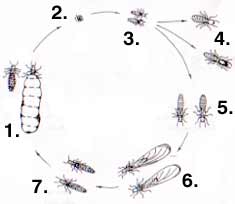|
Termites
1 2 next
 View / Download article: Biology and Control of Subterranean Termites (PDF) View / Download article: Biology and Control of Subterranean Termites (PDF)
 View / Download article: Dealing with Termites Termite (PDF) View / Download article: Dealing with Termites Termite (PDF)
What Are They?
Termites, often known as white ants are wood eating insects. Termites are highly variable in size, color and shape, but have many similarities. All Termites belong to the order Isoptera.
Termites are social insects and live in colonies. Some termites live in mounds above ground (e.g. Magnetic termites), some live in nests up telephone poles (e.g. Nasutitermes species), some in the base of trees and stumps( eg.Coptotermes species), and some even live in the very timber walls of the home.
Termite Colonies
All termites consume cellulose found in timber, paper, cardboard, and grass.
Termites live in groups or colonies up to several million in number. In any colony there are several different forms called castes. Worker castes are for food supply and tunneling. Soldier castes for defense of the colony and Reproductive caste for future generations and colony survival. Reproductive termites are often referred to as alates. The worker and soldier castes are sterile. All termites consume cellulose (found in timber, paper, cardboard, grass etc) as their food source.
Termite Behavior
Termites are often associated with mounds, but also form subterranean nests underground in root systems of trees or timber stumps. Termites nest in soil fill and building material under concrete slabs in patios, veranda's and paths around the premises.
Termites can nest in the trunk of a tree just above soil level or sometimes higher up in the fork of a branch where moisture has entered the tree causing decay. Termites can tunnel 50 to 80m from their nest to a feed site, for example from a tree 3 house blocks away to a piece of skirting in a building.
Coptotermes termite workers are 5mm to 8mm long with the soldiers slightly larger having a darker head and pincers or biting jaws called mandibles on their head. These mandibles are used for protection of the termite colony.
Flying Termites
Termites fly in the warmer summer months, normally when the humidity is high in the evening when the flying caste members, known as alates (6.) take to the wing in a Nuptial flight. They swarm into the air from infested timber in the building or from an infested tree. The alates pair up after a short mating (7.) display and tunnel into the soil to start a new colony. This process of release and pairing up is very hazardous with a high mortality rate from natural predators and exposure to the elements.
The alates are sexually mature males and females whereas the other termite castes are sterile. There is normally one Queen termite per nest and she can measure up to 4cm in length and live for 40 years. The Queen is very productive in her lifetime and can produce as many as 40,000 eggs (2.) per day. The King and Queen (1.) are entombed in the egg laying chamber in the center of the colony and co-ordinate the daily activities of the worker (4.) and soldier (5.) termites.

Termite colonies only flight when the colony is mature, anything up to 5 years after the original nuptial flight.
Conditions that can make your house vulnerable to termite attack.
- Filled areas. (Soil and builder's rubble
under patios and verandas often contain concealed waste timber products.)
- Concrete slab on ground. (Termites remain
concealed under the slab floor. Unknown entry points through slab cracks,
joins and plumbing fittings).
- Timber stumps. (Often covered in garden
beds or left in ground after tree felling).
Low clearance areas under floor. (Low subfloor areas under the home
prevent physical access for inspection and termite entry points are
concealed. Ducted heating restricts physical access and visual inspection.)
- Damp areas. Poorly ventilated areas. (Termites
attracted by fungal growth in damp soils).
- Form work timbers left in place after construction. (Timbers below ground level in garden beds attract foraging termites).
- Timber retaining walls. Garden sleepers.
(Too close to home attracts foraging worker termites. Possible nesting
sites).
- Leaking pipes, gutters and down pipes,
as well as garden sprinklers directed toward home. (Damp soils around
the home attract Termites).
- Damp timber caused by leaking pipes. (Fungal
growth attracts termites).
- Garden beds built over the edge of the slab. (Allows easy access for termites, concealed entry). Concrete paths built over the edge of the slab. (Hidden
entry points into the home).
- Weep holes blocked or covered up in brickwork
along the slab edge. (Termites entry points).
- Timber offcuts left under the home. (Termites
attracted to timbers by odour and decay).
Trees and tree stumps within 50m of home. (Termites nest in trees and
can feed on timbers in a 50m range).
- Timber support stumps. These should have
ant caps installed to force termites into the open for easy detection.
- Adjoining properties and zero lot lines. Party walls and zero lot lines can restrict access for inspection as
well as allow termites’ undetected entry from neighbour's building.
1 2 next
© 2011-2022 LazrWebSites all rights reserved
|

